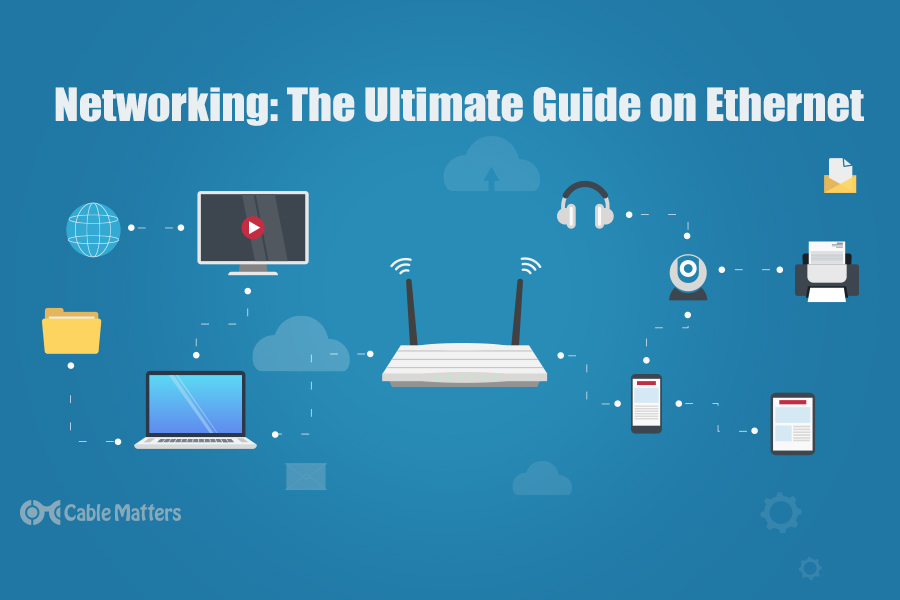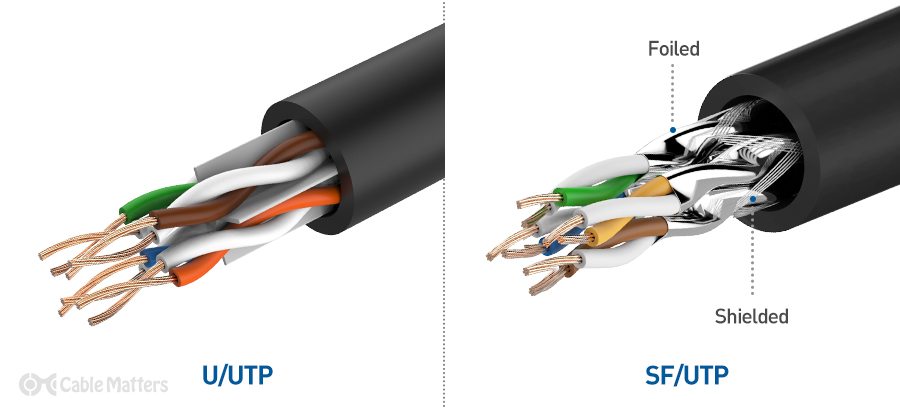
Smartphones, laptops, and tablets might prefer Wi-Fi as their favorite way of connecting to local networks and the internet at large, but wired Ethernet still represents the fastest and most stable way to get and stay online today. With a wide array of cables, adapters that let systems without Ethernet ports connect to a wired internet connection, and ever faster connection options, Ethernet connections offer a breadth of choice and versatility.
This is the ultimate guide to Ethernet networking in 2020.
A brief history of Ethernet networking
Ethernet is the name for a collection of technologies that have been used to connect computers and other devices together for decades. They typically form the connective branches of local area networks (LAN) and wide-area networks (WAN) before handing the connection off to more robust cabling that connects to internet service providers and international exchanges.
The earliest standards of Ethernet networking originate from the early 1970s, drawing inspiration from earlier networking tests like ALOHAnet. It was continually iterated upon throughout the 70s and was made commercially available and standardized in the early 1980s. At that time coaxial cables were the dominant form of connective technology supporting a bit-rate of just 10 megabits per second across a local network. In the decades that followed, as higher bit-rates and bandwidth were required, a slow transition was made to twisted pair and fiber optic hardware, along with newer switch technology, which has enabled speeds of up to 400 gigabits per second.
Although there have been competing networking technologies over the years, Ethernet's adaptation to changes in the market and adoption of new hardware to provide greater stability and speeds meant it won out in the end. Today, it's the dominant form of wired networking the world over and provides high-speed connections to millions of homes and datacenters and billions of individual devices.
Ethernet at home
Ethernet is used widely in a variety of industries, but it is perhaps best known by the general public for the cables that connect their home network to the wider internet. Cables with RJ45 headers connect desktop and laptop PCs to the local router。
If you've ever shopped for an Ethernet cable on a store like Cable Matters though, you'll have come across these labels, but you may also be familiar with cable designations such as Cat5 and Cat 6. These denote a category of cable used for Ethernet networking and have an important role to play in the capabilities of any network. A LAN is only as fast as its weakest point, and whether you're setting up a high-speed network with Ethernet cables for gaming and media viewing, or just need something simple for web browsing and watching YouTube, picking the right cable is important.
Older Cat5 standards offer lower speeds and features, while much more modern standards like Cat 6, and even Cat 8, support far greater bandwidths and offer better shielding for a cleaner and more stable connection.
Picking the right cable: Cat5e vs Cat6
The two most popular Ethernet cables used today are the Cat5e and Cat6 twisted-pair cables. Picking the right one for you means figuring out what it is you need from your network and what your network is capable of. Whether you need Ethernet cables for gaming, or something less intensive and latency-dependent, taking a closer look at these two cable types can give you a better idea of what you need.
Before we dive into the specifics of these cables, though, we need to address acronyms. These are common in any tech industry, but cables have a number of their own unique ones. TP, stands for Twisted Pair, for example, and references the way that wires are wound together inside Ethernet cables. "S" and "U" designations next to that acronym denote that a cable is shielded, or unshielded. "F" means foiled; a foil wrapping around the whole cable and/or individual wires. So, a cable that was UTP, is an unshielded twisted pair. An FTP is foiled with foiled twisted pairs. An SFTP is shielded and foiled over the whole cable, but the individual twisted pairs are unshielded.

It's a little complicated, but just consider that if data integrity is important to you, paying a little more for foiled and shielded wiring is a great idea.
For the Cat5e vs Cat6 debate, we need to consider their specifications first. Cat5e is the older standard, officially superseding the Cat5 specification in 2001 to improve maximum bandwidth capabilities and reduce crosstalk, which can negatively affect the quality of a connection. It expanded the theoretical maximum network speed to 1,000MBps or one gigabit per second. It has a typical wire gauge of 24-26 and a maximum cable length of 100 meters – far longer than your average HDMI cable, for example.
Cat6 further improved upon the advancements made with Cat5e, by increasing performance over longer length cables and decreasing cross-talk even further. With support for frequencies up to two and a half times that of Cat5e cables, Cat6 can deliver up to 10,000 Mbps, or 10 gigabits per second over lengths of cable up to 55 meters. It still has a maximum length of 100 meters, however, with the longest of Cat6 cables forced to work at the slower, 1,000Mbps speed of Cat5 cables.
On top of its speed benefits, Cat6 cabling also has to adhere to far higher standards of crosstalk and system noise mitigation than Cat5e. To achieve those goals, manufacturers often use a spline -- a longitudinal separator -- within the cable to isolate individual wires within the Ethernet cabling. The wires are twisted tighter too, providing increased protection from exterior noise sources. This has the added benefit of preventing a Cat6 cable from stretching unnecessarily, but it can make the cables more rigid, so it's not always used.
There is also a variant of Cat6 called Cat6A, which further improves performance, offering up to 10 gigabits per second at up to 100 meters. But beyond its raw performance, Cat6A also enhanced the shielding and anti-noise protection. Alongside individual wire shielding, shielded Cat6A cables (also available as unshielded) employ a drain, or ground wire to help eliminate any background noise or crosstalk from another cabling. This additional shielding makes Cat6A cables an excellent choice for high noise environments, and where data accuracy is of the utmost importance, like healthcare and education networks.
Ultimately, Cat6 cables offer an improved signal to noise ratio (SNR) than Cat5e, and a better, cleaner signal with fewer errors. Cat6A goes one step beyond that for an even cleaner signal.
It is important to remember too, that while Cat6 is a newer standard and features improved specifications over Cat5e, it is backward compatible. They are available with the same end-point connectors, so you won't run into any problems buying a Cat6 cable if your network has previously used Cat5e or Cat 5 cables. Indeed, if your network hardware like your device(s) and router can handle it, you may even see improvements in your network speed and stability with a Cat6 cable.
If you need to choose between Cat5e vs Cat6, Cat6 is the better bet, as it will future-proof your network. Few people require more than the 10Gbps bandwidth it offers, and that's unlikely to change in years to come.

What is Cat7?
Cat 7 is, much like Cat5e and Cat6, a generation of Ethernet networking cable. Like the Cat5e vs Cat6 debate, Cat7 is also a newer generation. It might be overkill for most home networks, but what is Cat7? It's a cable standard like Cat5e. That's not the whole story, though.
Although it was developed earlier, Cat7 effectively accomplishes the same thing as Cat6A, with the same 10,000Mbps – or 10 gigabits per second – the speed at up to 100 meters. Cat7 also has shielding for each individual wire pair within the cable, and the cable as a whole (SF/FTP).
But why the need for two cable standards that are effectively the same? Cat7 uses a proprietary connector that is different from the standard RJ45 connector. Cat7 is not approved by the Telecommunications Industry Association (TIA) or the Electronic Industries Alliance (EIA). Because of that, Cat7 isn't commonly used or supported.
With that in mind, most home users today stick with Cat5e or Cat6, while power users have moved on to Cat8 which offers far greater performance over shorter cable lengths. Those often require shielded connectors, however, like fully-metallic field termination plugs designed with servers and network switches in mind.
Do you need Ethernet cables for gaming?
Wi-Fi technology has come on a lot in the past decade and a half, offering greater speeds, improved reliability, and far greater range. That makes it a perfectly viable solution for gaming, whether you're playing games through a digital storefront that requires an internet connection, or high-speed multiplayer games where ever millisecond of lag can impact your gaming performance.
But where wired networking might feel like an older technology when it comes to home networking, it's still the more reliable solution. You don't technically need Ethernet cables for gaming, but you are likely to have a better experience if you do.
The biggest advantage Wi-Fi has over Ethernet cables for gaming is convenience. It is far easier to set up a wireless network and connect your gaming PC to it from another room than it is to route cables through walls and under carpets. But that's where the advantages stop.
The latest generation of Wi-Fi, Wi-Fi 6 (802.11.ax) has a maximum theoretical combined speed of 11 gigabits per second, which is comparable, and even slightly in-excess of Cat6 or Cat7 Ethernet connections. But that's in an ideal scenario and more than likely not possible in your home. That means no interference from walls, no other devices crowding the wireless channels with their own traffic, and your connected system being within close proximity to the router. All things that are unlikely to be the case with a wireless internet connection.
Problems with Wi-Fi can lead to a slower connection, packet loss (which can result in stuttering gameplay) or delays (which leads to lag). Although interference like this isn't impossible on an Ethernet connection, if you use a high-quality cable then it's very unlikely. Ethernet cables for gaming can offer a more stable and cleaner connection, making your gaming experience that bit better.
Don't want to run cables under the carpet or through walls, though? You could always use power-line networking with a small Ethernet cable at each end.
If your device doesn't have an Ethernet port though, don't fret. There are adapters that can make it possible to connect an Ethernet cable to just about any device.